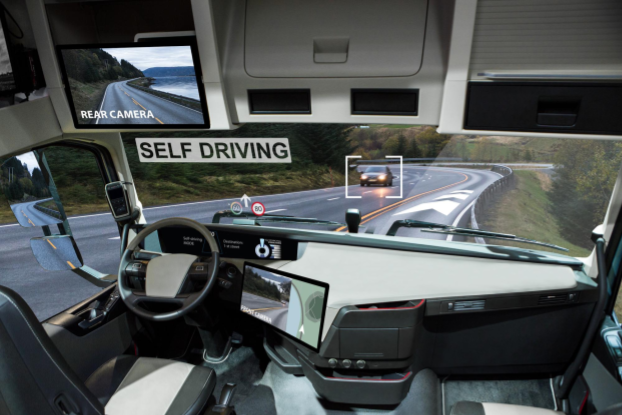An Honest Look at Vehicle Automation: The Pros and Cons of Self-Driving Cars

Due to continued advancements in automation and artificial intelligence, self-driving cars are quickly becoming a reality instead of just a dream. Fully autonomous vehicles are still not widely available, but many cars already have some assistive features or partial autonomy. As more vehicles move closer to full autonomy, it becomes increasingly important to consider all of the impacts — both positive and negative — self-driving cars may have on the world and its inhabitants in the coming years.
Pros of Self-Driving Cars
Though their effects have yet to be fully explored, it’s believed that self-driving cars could have benefits for public safety, the environment, and the economy.
Safety
Self-driving cars have the potential to be safer than cars driven by humans. Currently, the open road is dangerous and, often, lethal. In the United States, millions of people are injured in motor vehicle crashes each year; further, for people aged 1 to 54, traffic crashes are the leading cause of death.
Research from the National Highway Traffic Safety Administration found that up to 94% of serious crashes — the overwhelming majority — are caused by human error or choice. Self-driving cars will not be operated by human drivers, which could drastically reduce this number. They could be programmed to drive more defensively or follow the rules of the road more closely, working to bring down the number of crashes overall.
Other features could make self-driving cars even safer, including:
- Autonomous emergency brakes;
- Lane assist controls;
- Blindspot detection;
- Electronic windshields;
- Communications between cars;
- Adaptive cruise control;
- Parking assistance;
- Vehicle guidance systems.
It can be difficult to make travel safer, especially on the road, but many of these cars already have some of these safety features — with promising results.
Accessibility
Self-driving cars offer more freedom and independence to people who are unable to drive. These individuals wouldn’t have to rely as heavily on other people, ridesharing services, or public transportation to get around. This can, for example, make it easier to support senior family members or transport children from school to practice.
Driverless cars could be especially helpful for individuals with disabilities, especially people with limited mobility or vision impairments. A report from the Ruderman Foundation discovered that widespread adoption of autonomous vehicles would open up employment opportunities for two million people with disabilities and save $19 billion in healthcare expenses from missed medical appointments alone.
Of course, this future is still a ways away, and poses an entirely new set of questions, including how manufacturers can make driverless cars themselves accessible for all users. However, the rise of ridesharing services and the availability of full-time personal drivers provides a comparable amount of independence or the ability to provide children with transportation while this technology is being developed.
Environmental Impacts
Self-driving cars could be highly beneficial for the environment, helping countless individuals reduce their carbon footprints. The National Renewable Energy Laboratory (NREL) estimates that driverless vehicles could lead to 90% fuel savings, as well as lowering the amount of energy used to manufacture vehicles.
Widespread adoption of self-driving cars may also decrease traffic congestion, further benefiting the environment. There may be fewer cars on the road, but the remaining autonomous vehicles would be able to drive more efficiently. Researchers suggest that, by eliminating stop-and-go waves of traffic, driverless cars could reduce fuel consumption by up to 40%.
However, self-driving cars must be created with their environmental impact in mind. The NREL report linked above found that driverless cars could boost energy usage by 250%. In addition, self-driving cars are expected to increase demand for transportation; if they are not electric or shared vehicles, greenhouse gas emissions could rise 50% by 2050. Essentially, these consequences can be avoided and driverless cars can help the environment as long as the proper precautions are taken.
Economic Impacts
Driverless cars are expected to have a strong impact on the economy. One report predicts that, by 2050, the adoption of self-driving cars could generate $800 billion in economic benefits. Another estimates that there could be a $7 trillion economy surrounding autonomous vehicles by that same year. But the economic stimulation stemming from creation, development, and manufacturing of driverless cars is just the beginning.
From legal fees to healthcare expenses, car accidents can cost the U.S. hundreds of billions of dollars in a single year. If self-driving cars do improve road safety, they won’t just lower the number of crashes — they’ll also reduce the amount of money spent on crashes. Depending on their safety impact, this could result in billions of dollars saved annually.
Cons of Self-Driving Cars
For all their advantages, there may be some drawbacks associated with self-driving cars, especially for cybersecurity and the economy.
Moral Dilemmas
Self-driving cars bring up ethical questions and moral dilemmas that are not easily solved. Should cars be programmed to protect the lives of passengers or pedestrians in the event of a collision? Should cars be programmed to place more value on certain human lives than others (such as saving the life of a child over a senior citizen)? Should driverless cars be programmed with a universal moral code, so all vehicles respond the same way in every place and situation?
Researchers have just begun to explore the morality of self-driving cars. One study, called the Moral Machine Experiment, surveyed millions of people all over the world to discover their opinions on moral quandaries associated with self-driving vehicles. This survey raises more questions than it answers, showing that there is no “right” way to program driverless vehicles. However, these questions do need to be answered before fully autonomous vehicles hit the streets in earnest.
There is also the issue of accountability in the event of a crash. When human error causes an accident, it’s clear who is at fault, but it’s much harder to determine legal and financial responsibility when the car drives itself.
Cybersecurity
Because they are powered by sophisticated connective technologies, self-driving cars are susceptible to cybersecurity threats. Hackers could take advantage of vulnerabilities in vehicles’ computer systems and take control of the car from a remote location. At best, this could be an unsettling experience for drivers and passengers; at worst, it could be lethal for anyone in the car, as well as other drivers on the road.
Many people are fearful of these cybersecurity risks and driverless vehicles in general. According to one AAA survey, only 12% of drivers would feel safe riding in a self-driving car, with half citing concerns about hacking vulnerability. It will likely take time, information, and a track record of safety to alleviate these fears. However, it’s difficult to build trust if people are too fearful to give driverless cars a chance.
Economic Impacts
Though they may generate money, self-driving cars might also have negative effects on the economy. Unemployment is the primary concern associated with the adoption of driverless vehicles. Truck, taxi, ridesharing, and bus drivers — and the staff who support them — could all lose their jobs. According to some estimates, millions of driving jobs are at risk.
Driverless cars are also expected to be costly. Many cars with self-driving features are already quite costly, with even the most affordable pushing $30,000. Fully autonomous vehicles may be too expensive for most consumers to purchase; the cost of hiring a personal driver would be more affordable by comparison. This is a large barrier that prevents everyone, including society as a whole, from enjoying the benefits of self-driving cars.
Accessibility
Some experts worry that, cost aside, driverless cars will not be widely accessible. They will rely on GPS to navigate, but, unfortunately, GPS works with varying accuracy. They may need to use cell phone signals, Bluetooth, and other connections to function. However, these connections are not always reliable or available, limiting the area in which self-driving cars can be used. If they fail mid-ride or outside of a certain range, this can even put users’ lives at risk.
Ultimately, it will be impossible to know how self-driving cars will impact society until the technology is fully developed and they’re widely used. The benefits and concerns listed above are only a few of the effects autonomous vehicles could have. As they become more commonplace, driverless cars will likely have even more unintended and unforeseen consequences for the economy, environment, and society as a whole.

